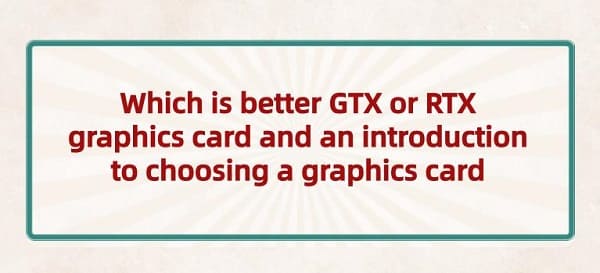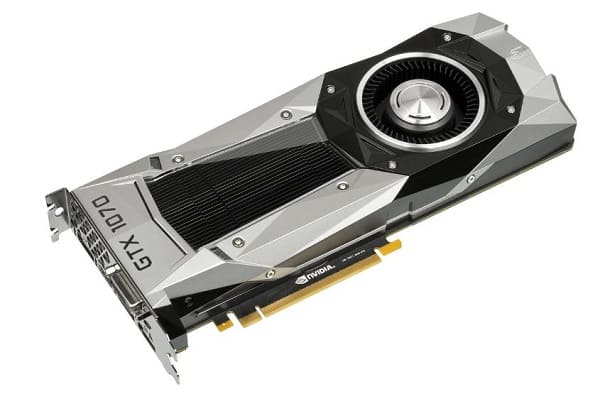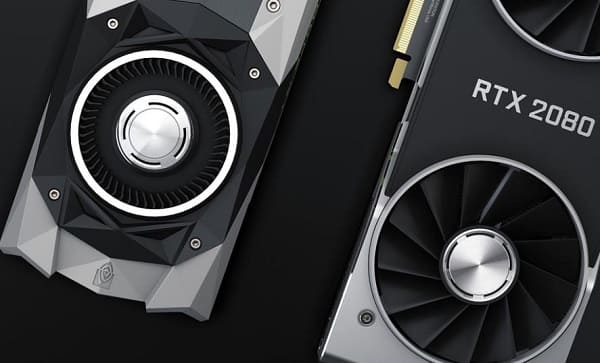
NVIDIA graphics cards are known for their excellent performance and stability in computer graphics, providing smooth gaming experiences, efficient video editing and rendering capabilities, and accelerated artificial intelligence tasks. Their graphics processors are widely used in the gaming industry, offering a variety of graphics effects and technologies such as ray tracing, DLSS (Deep Learning Super Sampling), and physics simulation, significantly enhancing the visual and performance aspects of games. NVIDIA graphics cards play a crucial role in the field of computer graphics and computation, serving as important infrastructure in many industries.
Contents:
1. Types of NVIDIA Graphics Cards
2. Comparison of GTX and RTX Performance
3. Which One Is Better, GTX or RTX
4. How to Choose a Graphics Card
1. Types of NVIDIA Graphics Cards:
1). GeForce GTX Series:
Mainly targeted at gamers and consumer markets.
Offers outstanding gaming performance and graphics processing capabilities.
Common models include GTX 1650, GTX 1660, GTX 1080, etc.
Suitable for various games, capable of running smoothly at high resolutions and quality settings.

2). GeForce RTX Series:
Introduces ray tracing and artificial intelligence (AI) technologies, providing more realistic graphics effects and higher performance for games.
Supports real-time ray tracing and DLSS (Deep Learning Super Sampling) technology, enhancing the realism and smoothness of game graphics.
Common models include RTX 2060, RTX 3070, RTX 3080, etc.
Suitable for gamers pursuing high graphics quality and effects, as well as creators requiring professional graphics performance.

3). NVIDIA Titan Series:
Targeted at high-end gamers, professional users, and research fields.
Offers extremely high computational performance and memory capacity.
Provides excellent gaming performance and processing capabilities while supporting deep learning and scientific computing.
Common models include Titan RTX, Titan Xp, etc.
4). NVIDIA Quadro Series:
Aimed at professional workstations and creator markets.
Provides professional-level graphics performance and reliability.
Suitable for CAD design, video editing, virtual reality, and other professional applications.
Common models include Quadro RTX 5000, Quadro P5000, etc.
5). NVIDIA Tesla Series:
Mainly used in high-performance computing and scientific computing fields.
Provides high-performance parallel computing capabilities for supercomputers and data centers.
Supports applications such as deep learning training and inference, large-scale data analysis, etc.
Common models include Tesla V100, Tesla P100, etc.
2. Comparison of GTX and RTX Performance:
1). Ray Tracing and DLSS Technology:
RTX Series: RTX cards are among the first to support ray tracing technology. This technology simulates the propagation paths of light in the scene, achieving more realistic lighting effects, including realistic shadows, reflections, and refractions. Additionally, RTX cards also support DLSS (Deep Learning Super Sampling) technology, an AI-based image rendering technique that improves game frame rates while maintaining image quality.
GTX Series: GTX cards do not support ray tracing and DLSS technology, making them relatively less advanced in these aspects compared to RTX cards.
2). Performance:
RTX Series: Due to support for ray tracing and DLSS technology, RTX cards excel in realistic lighting effects and image rendering. In games that support ray tracing and DLSS, RTX cards can achieve higher frame rates and better image quality.
GTX Series: GTX cards also offer good performance, suitable for running most games and applications. However, for games that require ray tracing and DLSS technology, GTX cards may not provide the same satisfactory performance.
3). Price:
GTX Series: With their lower prices, GTX cards are suitable for users with budget constraints who still want decent gaming performance.
RTX Series: RTX cards are priced higher due to their support for advanced technologies. They are more suitable for users who prioritize top-tier gaming experiences and the latest technologies.

4). Power Consumption and Heat Dissipation:
RTX Series: Due to support for more advanced technologies, RTX cards typically have higher power consumption and heat dissipation requirements. Therefore, it is important for users who need to consider power consumption and heat dissipation to choose suitable power supplies and cooling solutions.
GTX Series: Relatively speaking, GTX cards have lower power consumption and heat dissipation requirements, so considerations in this regard may be relatively less.

3. Which One Is Better, GTX or RTX:
1). Graphics Performance:
GTX Series: GTX cards offer powerful graphics performance, suitable for running most games and applications. They provide good gaming performance at a relatively affordable price.
RTX Series: RTX cards are more powerful in terms of graphics performance, especially in games that support ray tracing and DLSS technology. This allows RTX cards to achieve more realistic lighting effects and higher frame rates, providing a more immersive gaming experience.
2). Support for New Technologies:
GTX Series: GTX cards are based mainly on traditional graphics rendering technologies and do not support new technologies such as ray tracing and DLSS. Therefore, they may not achieve optimal performance in games that require these advanced features.
RTX Series: RTX cards introduce new technologies like ray tracing and DLSS, enabling more realistic game visuals and higher performance. For games that support ray tracing and DLSS, RTX cards offer better visual effects and gaming experiences.
3). Compatibility:
GTX Series: Due to their widespread market share and mature technology support, GTX cards have good compatibility with games and applications, capable of running most software well.
RTX Series: While RTX cards support advanced features like ray tracing and DLSS, there may be some compatibility issues, especially when these new technologies are first introduced. However, with time and driver updates, these issues are usually resolved.
4). Gaming Performance:
GTX Series: GTX cards provide strong gaming performance, capable of running most games at high resolutions and quality settings. They offer good value for money and are suitable for casual gamers.
RTX Series: RTX cards offer superior gaming performance, especially in games that support ray tracing and DLSS. With these technologies, RTX cards deliver more realistic lighting effects and maintain smooth performance at high resolutions and quality settings.

4. How to Choose a Graphics Card:
Budget: Determine your budget range first. Graphics card prices vary widely, ranging from tens to thousands of dollars. Choose a graphics card that offers the best performance and features within your budget.
Usage: Consider what you intend to use the graphics card for. For everyday office tasks, web browsing, and watching HD videos, a mid-range graphics card is sufficient. However, if you're a gaming enthusiast, video editor, or need to perform professional 3D modeling and rendering work, you may require a high-performance graphics card.
Performance Requirements: Determine your performance requirements based on your usage. For gamers, frame rate and image quality are crucial factors, while video editors may prioritize processing speed and rendering performance.
Compatibility: Ensure that the selected graphics card is compatible with your computer hardware. Check if your motherboard has the appropriate slot for the graphics card (e.g., PCI Express x16 slot), and make sure your power supply can support the graphics card's power consumption requirements.
Brand and Model: Consider the performance, quality, and after-sales service differences between different brands and models of graphics cards. Well-known brands such as NVIDIA, AMD, ASUS, Gigabyte, etc., typically offer more reliable and stable products.
Price-to-Performance Ratio: When choosing a graphics card, consider the balance between performance and price. Sometimes, lower-priced graphics cards may offer relatively good performance, while high-end graphics cards may have higher price-to-performance ratios.
Future Upgrades: Consider whether you plan to upgrade other hardware components in the future, such as the processor or memory. If you intend to upgrade in the future, you may need to choose a more powerful graphics card to meet future requirements.
User Reviews and Professional Reviews: Read reviews from other users and professional reviewers to understand the performance, stability, and durability of the graphics card. This information can help you make a more informed decision.
These are the detailed comparisons between GTX and RTX graphics cards, as well as guidance on how to choose a graphics card. If you encounter issues with network cards, graphics cards, Bluetooth, sound cards, etc., you can use "Driver Talent" for detection and repair. Additionally, Driver Talent supports driver downloads, installation, and backup, providing flexible driver management solutions.

See also:
Downloading and Installing Guide for Realtek Sound Card Drivers
Steps to clean up a full C drive on the computer
How to Solve the Issue of Keyboard Lights Not Turning On









